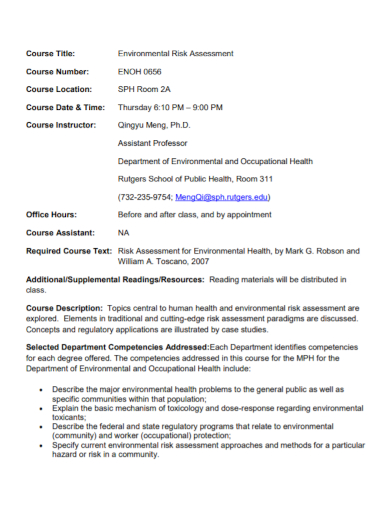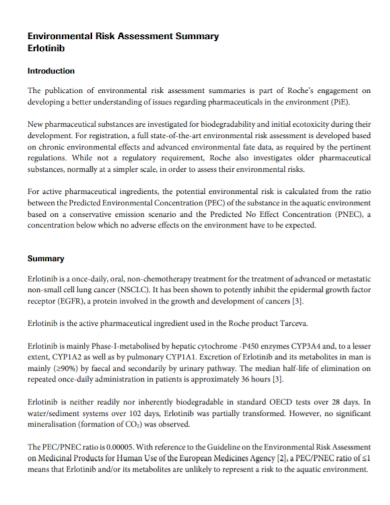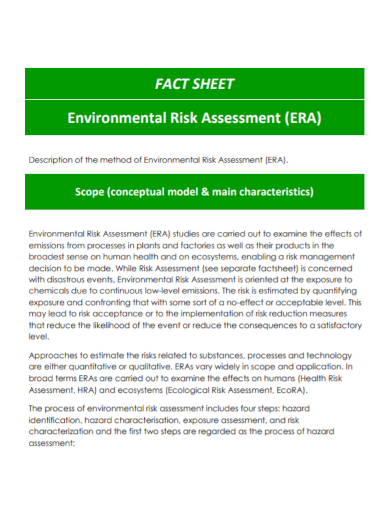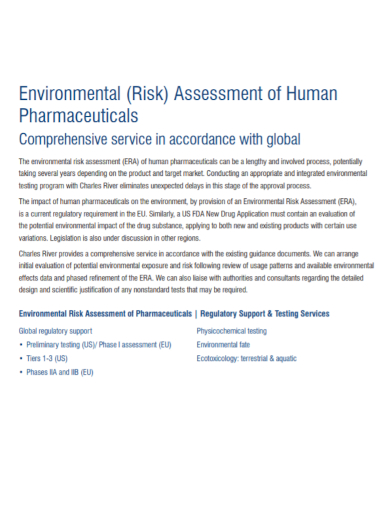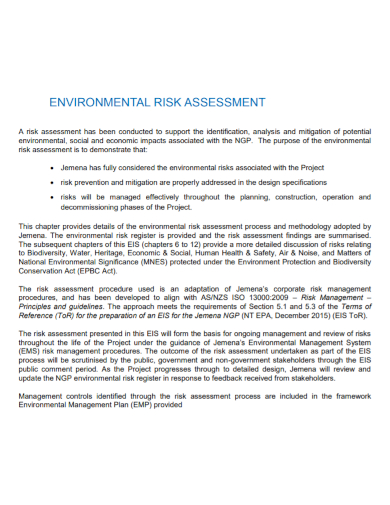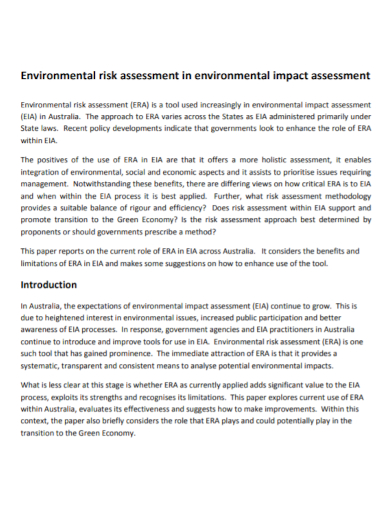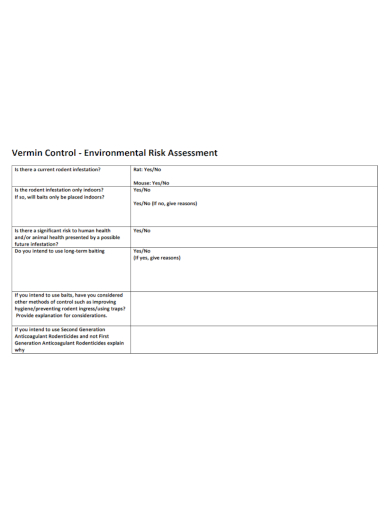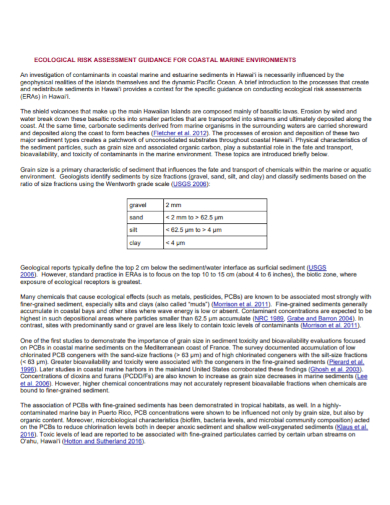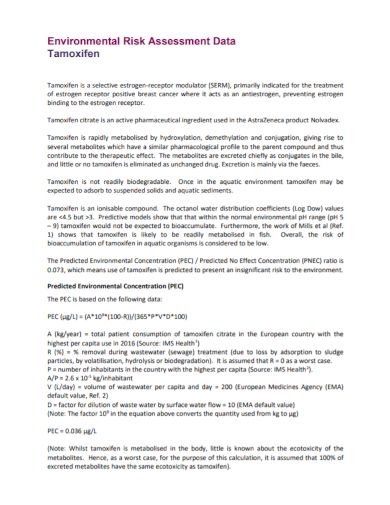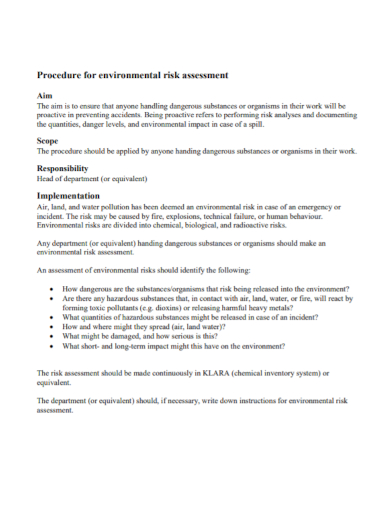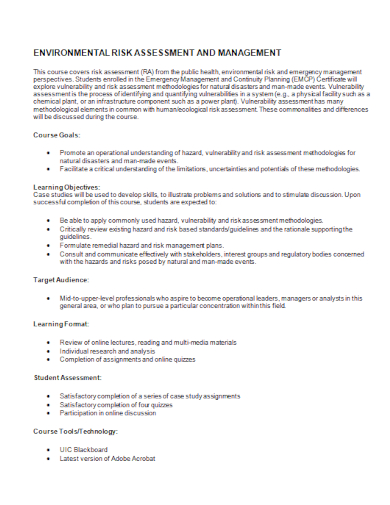Environmental Risk Assessment (ERA) as “a process of analyzing and describing the risks associated with a project or activity to ecosystems, human health and welfare”. Risk is defined as a measure of potential human injury/ death, economic loss, or environmental damage in terms of the probability of the loss, injury/ death or damage occurring and the magnitude of the loss, injury/ death or damage if it occurs. It is the product of the calculated consequence of a postulated accident scenario and the probability or frequency of occurrence of such event. Generally, risk assessment identifies and assesses the potential risks to human health and safety. It is also intended to assess the proposed safety management schemes that would minimize if not eliminate such hazards and risks.
10+ Environmental Risk Assessment Samples
1. Environmental Risk Course Assessment
2. Environmental Risk Summary Assessment
3. Environmental Risk Assessment Fact Sheet
4. Environmental Pharmaceutical Risk Assessment
5. Environmental Risk Assessment
6. Environmental Risk Impact Assessment
7. Environmental Risk Control Assessment
8. Environmental Ecological Risk Assessment
9. Environmental Data Risk Assessment
10. Environmental Procedure Risk Assessment
11. Environmental Risk Management Assessment
What are the Environmental Concerns?
There are a lot of aspects of our environment that are facing issues and these issues should be addressed. Some of the major concerns include:
1. Biodiversity
Biodiversity is a collective term of every living thing and ecosystem that makes up the environment. It is the vital feature of the planet Earth. Everything has their own role to maintain the planet into a living place for everything to thrive on. However, some humans tend to abuse the environment in result, the biodiversity is in danger due to lobal warming, pollution and deforestation. Making sustainable choices can help save our biodiversity and help lessen all toxic and destructive activities to destroy it. because From the tallest giraffe to the smallest microorganism, everything plays an important role in the maintenance of our world.
2. Water
Water pollution is another huge concern for the environment. Water pollution is one of the biggest issues the planet is facing because it can kill animals, especially marine life, plants, and people. Pollution can cause diseases that could threaten and kill our biodiversity that’s why water pollution is a grave issue. The best thing to do to lessen water pollution is to educate people and implement stricter laws and regulations to mitigate water pollution.
3. Deforestation
Another grave issue the environment is facing is deforestation. Plants and trees need to thrive well because they provide oxygen, food, water, shelter, and medicine for humans and animals. Natural wildfires and illegal logging are the main causes of deforestation. With the loss of lush forests, greenhouse gas emissions are increasing making the planet warmer than ever before. It’s best to recycle products and use organic products. Limit the amount of paper to be used.
4. Pollution
Pollution is one of the primary environmental concerns. There are different types of pollution, air, water, soil, noise, radioactive, light and thermal, and they negatively affect our environment. These pollution are interlinked by one another. It’s important for the majority of us to take practical actions that help address and lessen pollution.
5. Climate Change
Currently, our planet is still suffering from global warming that results in climate change. Climate change is a huge concern because it changes our atmosphere, making it more hotter than usual and in effect, it could increase ocean temperature that will affect the sea life and ecosystems habituated there, and it could rise sea levels that will shrink land and cause mass floods and extreme weather conditions. Reducing carbon footprints, lessen the use of electrical items, and educating people about global warming can help save the planet.
Process of Environmental Risk Assessment
1. Hazard Identification
The first step of the risk assessment process is hazard identification. It identifies all potential events, processes, hazards, and substances that could lead to disastrous or fatal incidents that will negatively affect people and the environment.
2. Consequence Analysis
This is step estimates and assess the effects or results of a the disastrous incident. This step involves models such as release rates calculations, dispersion and physical effects to help assess the situation.
3. Frequency Analysis
This step estimates the likelihood of the occurrence of the identified hazard.
4. Risk Assessment
Risk assessment examines, analyzes, evaluates, analysis, and estimates the unexpected negative event that occurred that caused unacceptable impacts or results to people and the environment.
5. Risk Management
This encompasses the risk assessment process. It is the term applied to a logical and systematic method of identifying, analyzing, assessing, treating, monitoring and communicating risks associated with any activity, function or process in a manner that would enable one to minimize losses and maximize opportunities.
FAQs
How do you address environmental risk?
- Replace disposable items with reusable
- Pass on paper
- Conserve water & electricity
- Support local & environmentally friendly
- Recycle (& then recycle properly)
What are the steps of risk assessment?
- Step 1: Identify hazards, i.e. anything that may cause harm
- Step 2: Decide who may be harmed, and how
- Step 3: Assess the risks and take action
- Step 4: Make a record of the findings
- Step 5: Review the risk assessment.
What are the three types of environment?
The three types of environment are:
- Natural environment.
- Human environment.
- Physical environment
Risk management is a continuous process because conditions change. Review, monitor, and track risks periodically throughout your project. Uncertainty plays a major factor in risk management. If you build a process around that uncertainty, you can minimize risk for your project. With less risk, it improves your chances of achieving your project goals. To help you get started creating the checklist, download our free sample templates above to use as your guide!
Related Posts
FREE 10+ Teleworker Self-Assessment Samples in PDF | DOC
FREE 10+ Market Assessment Samples in PDF | MS Word
FREE 10+ Quality Risk Assessment Samples [ Control, Assurance, Management ]
FREE 6+ Immediate Termination of Lease Agreement Samples in MS Word | Google Docs | Apple Pages | PDF
FREE 10+ Qualitative Risk Assessment Samples in PDF | DOC
FREE 10+ Comprehensive Needs Assessment Samples in PDF
FREE 10+ Evaluation Quality Assessment Samples [ Self, Loss, Data ]
FREE 10+ Promotion Assessment Samples [ Health, Self, Employee ]
FREE 10+ Employee Competency Assessment Samples in PDF | DOC
FREE 10+ Safety Assessment Samples [ Home, Health, Risk ]
FREE 10+ Qualitative Assessment Samples in PDF | DOC
FREE 10+ Staff Assessment Samples [ Workplace, Health, Risk ]
FREE 10+ Vulnerability Assessment Samples [ Security, Network, Risk ]
FREE 6+ Vendor Risk Assessment Samples [ Management, Security, Financial ]
FREE 10+ Work Assessment Samples [ Social, Capability, Risk ]

